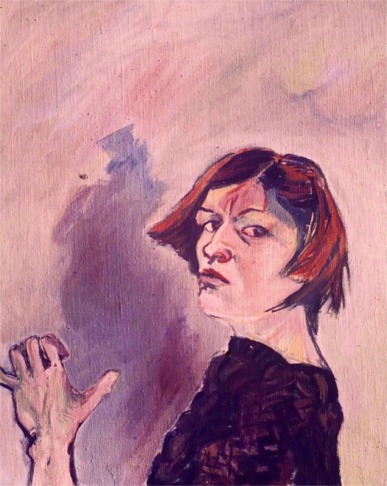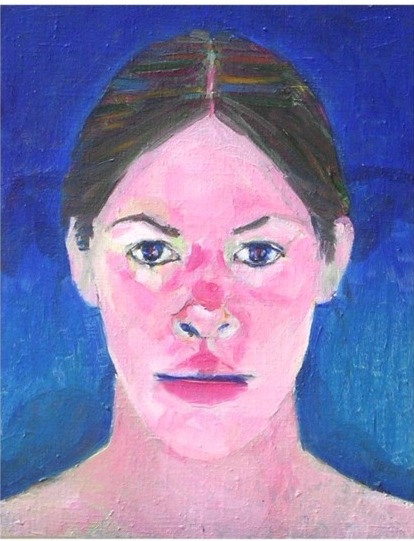|
|
 |
 |

"Contemplating
A Tiny Black Planet"
oil 26" x 26" 1976
(lost in San Francisco, reward offered) |
"Contemplating
a Tiny Black Planet"
I could not live with it, this sterile dark depression
like a stigmata floating out before me, unavoidable
as if a tiny piece of black tape were between me and everything.
So I focused on that point, let go image and reflection
vision blurred, my concentration rarefied and saw all three
the spot was now the standard
and its echo lived inside, cutting, tearing, silently imploding
'till flesh became fuller broader entirely diffused
into a landscape,
a landscape with no sky.
"Contemplating
a tiny black planet" is a line taken from a poem by Jerry
Ratch, friend of Curt Thayer
|
| Another
work by Susan Holsclaw, "Contemplating a Tiny Black Planet"
(also 1976) makes use of a related visual method. It is a self-portrait,
painted from a mirror, using a piece of black tape on the mirror
in the attempt to locate a focal point outside the eye thus
shattering the image as well as 'organizing' it. This is more
a Carlos Castanada idea and the resulting work is dramatic-sort
of a cross between a landscape and a portrait- a landscape with
no sky, though we do find the color blue around the latitude
of the eyes. Here the subject is in the picture and in the strokes.
Still it has "content". In "Contemplating a Tiny
Black Planet" we feel something; compassion perhaps for
a blurring shattered face. It is somehow an affirmation of our
human plight, and it is a feeling in our eyes. It remains a
painting of something. |

Mirror
Mind" 12" x 9" 1987
|
"Mirror
Mind" (1989) is also a portrait, painted from looking into
a mirror. The image is conditioned by a hanging plaster rabbit
sculpture. On one side the rabbit is white with green spots; the
other side is flat with an inverted image of a pepper and a carrot.
The carrot is orange then over painted with blue, its compliment
but not a true color for "carrots"; the pepper is green
over painted with its compliment, red, which is another color
for peppers. (Sort of like yes-no, yes-yes). Hanging, as it does
in front of the mirror, we see both sides. The three elements
in the painting (arm, rabbit & face) are difficult to reconcile.
The arm (whose arm?) holds a sliver of glass which bisects the
rabbit and claims the surface of the mirror. The hand has color
stripes for fingers, like some exotic engagement ring. Does the
arm belong to the rabbit, the face or yet someone entirely else?
The white compressed space that severs the arm also vignettes
the portrait. The face has a calm clarity like a cold glass of
water. A golden door is suggested in the background. The disconnected
arm is maybe the most odd element but because of its (accurate)
placement to the face, the space around the figure becomes opaque
and felt as empty mirror. Compression? If you look at the 'light'
in the mirror; the face, the sculpture and the arm again come
together. The rabbit, the plane of the mirror, the "sliver
of glass" could have shattered the face as in "Contemplating
a Tiny Black Planet"(1976) but here the face defiantly refuses
to be broken. The arm refuses to let go. This is a determined
painting implying an intention to defend oneself. The arm vacillates
forward and back and the face remains beyond. It is a small work,
1/4 life size. A related work is "Small Nativity"(1988).
|

"Small
Nativity" oil 12" x 8.5" 1987
|

"Puberty" oil 12" x 15"
1971 |
|

The Ghosts Departs" oil 1972
(Lost in Amherst, MA. Reward offered)
|

"Portrait 78" oil 9" x 12"
1978 |
Another
portrait is "Puberty"
(1971). Here the face itself is the mirror. In "The Ghost
Departs"(1972) we see the anger of "Puberty" is
tempered by a deeper concern. In "Portrait" (1978) we
see a face with eyes, ears, nose, mouth, body; life size and "sentient".
When we look at paintings we should notice what happens to our
eyes. As we stumble over one stroke or another it activates other
areas of the painting and changes our focus. These things are
what painting is about. With photography, realistic painting diminished
but that made way for Impressionism, Expressionism, etc. With
computers, we can easily hypnotize and tickle the eyes. …possibly
even generate "content', but it may remain impersonal. (Am
I making a case for fashioning horns out of human femur bones?)
Well, not to relegate painting to the status of rare books, but
to say, paintings have 'presence'. Good paintings have good 'presence'
and that 'presence' is not limited to the person who created the
painting. There is an element of 'divinity' involved. One needs
to live with a painting to really get to know it. |
 |
 |
|